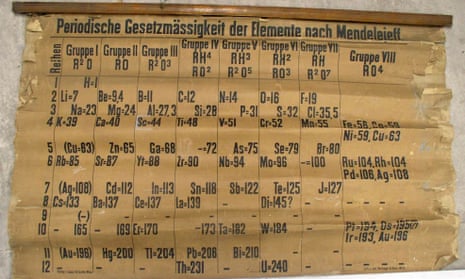A crumbling roll of canvas-backed paper discovered underneath a lecture theatre in Scotland may be the world’s oldest surviving periodic table chart, experts have said.
The chart was found during a clean-out at the University of St Andrews in 2014 and appears to date from 1885 – 16 years after the Russian chemist Dmitri Mendeleev published his method of showing the relationships between the elements in 1869.
Prof David O’Hagan, professor of organic chemistry at St Andrews, said the periodic table quickly became “an iconic and useful tool for chemists”. The fragile chart discovered in the clear-out was special, he told the Guardian. “If you [go] to universities and classrooms that teach chemistry there is always a periodic table hanging up, and this seems to be the earliest example of a display periodic table.”
While the chart would have been used to educate scientists, it looks rather different to the table most will be familiar with today. Written in German, it only contains 71 entries, although some elements crop up twice, including relative atomic masses for elements predicted to exist but not yet discovered – such as hafnium, which was discovered in 1923. “That has been the power of the table,” said O’Hagan.
The chart seems similar to Mendeleev’s revised table of 1871, said O’Hagan. “There are some errors and changes here in [the relative atomic masses] but essentially this table has held pretty strong and been added to.” There are 118 elements in the modern periodic table.
While today’s table is based on a detailed knowledge of the atomic structure of the elements, those in the chart are sorted into columns, or groups, based on their chemical reactions with oxygen or hydrogen, O’Hagan said. “These elements were grouped on their chemistry, not on their atomic structure.”
The noble gases, such as radon and argon, are absent, he said, “because they weren’t reactive so they weren’t noticed”.
Researchers at St Andrews said they had been able to trace the origins of the chart, which was printed in Vienna by Verlag v Lenoir & Forster. An entry in the financial records showed it was bought in 1888 by Thomas Purdie, a chemistry professor who had studied in Germany. He paid three German goldmarks, the equivalent of about £17.30 today.
Since its discovery the chart has undergone conservation, and is now part of the university’s special collection. “It was flaking quite badly,” said O’Hagan.
To mark 150 years since the publication of Mendeleev’s seminal work, the UN has declared 2019 the “international year of the periodic table”.
